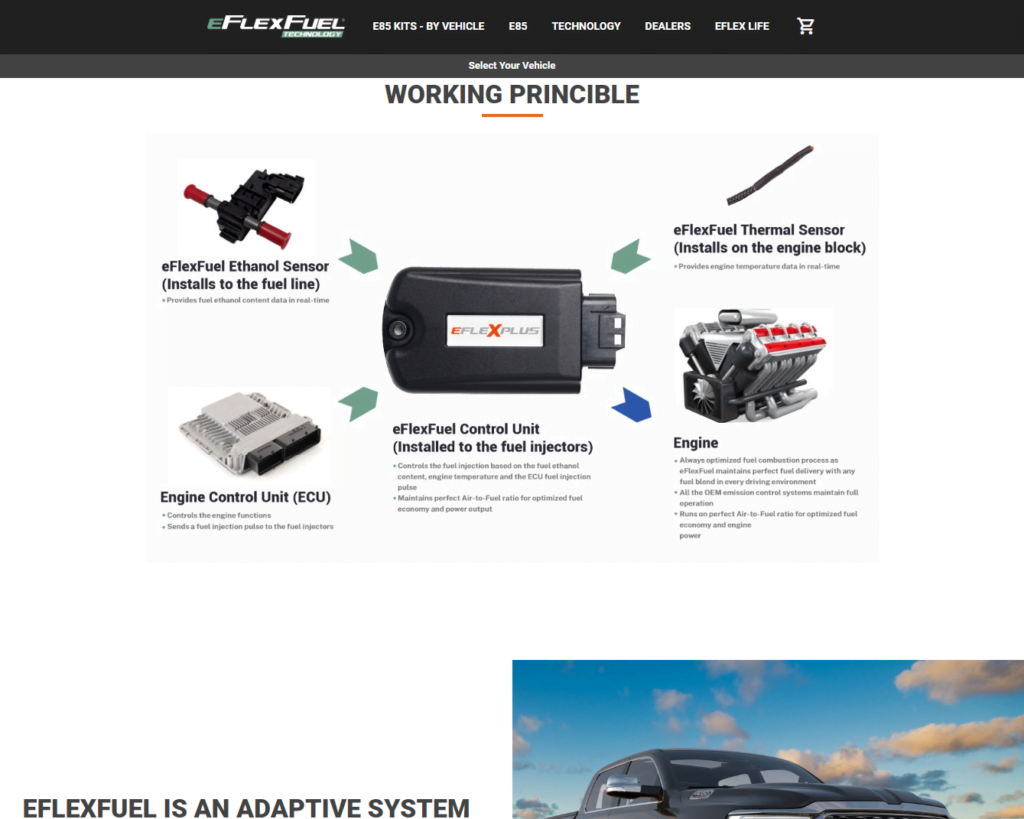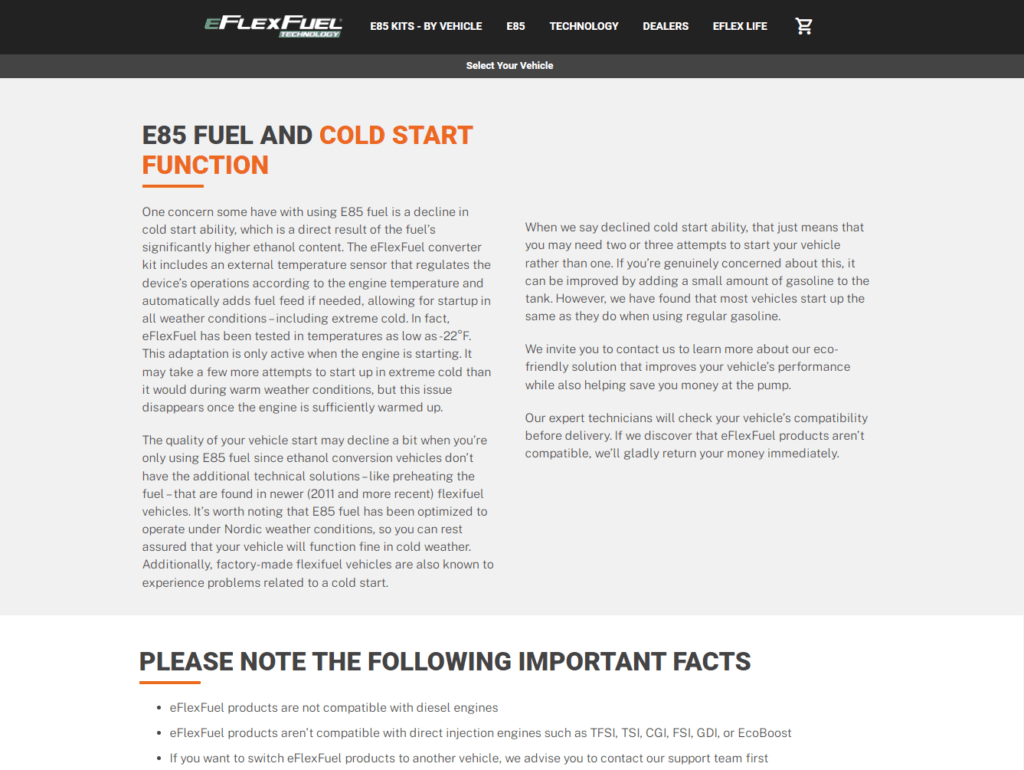

Benefits of Running E85
Are you intrigued by the idea of transforming your vehicle to run on ethanol-based fuel, commonly known as E85? In this comprehensive guide, we will delve into the world of E85 conversion kits, exploring their benefits, compatibility, and step-by-step installation process. So, whether you’re seeking to save money at the pump, unleash more horsepower, or reduce your carbon footprint, you’ve come to the right place.
Let’s find the benefits of Running E85
Picture this: you pull up to a gas station and spot a distinct yellow nozzle amidst the black ones. This yellow nozzle signifies E85, a fuel blend containing 85% ethanol and 15% gasoline, derived from corn. But what are the advantages of converting your vehicle to run on E85? Let’s explore three compelling reasons:

Financial Savings
One of the most prominent benefits of using E85 is the potential for substantial cost savings. At the pump, E85 is often priced lower than traditional gasoline, making it an attractive option for budget-conscious drivers. Consider this real-world example: while premium gasoline can cost upwards of $6.30 per gallon, E85 is priced at just $3.30 per gallon, resulting in a staggering three-dollar difference. Similarly, E85 is priced at $2.60 per gallon compared to $4.40 per gallon for premium gasoline, translating to a savings of $1.80 per gallon.
Enhanced Performance
If you’re an automotive enthusiast seeking to maximize your vehicle’s performance, E85 has much to offer. Particularly beneficial for boosted engines, such as supercharged or turbocharged powerplants, and high-compression ratio engines, E85’s high octane rating presents a unique advantage. Unlike traditional gasoline, E85 consistently boasts an octane rating exceeding 100. This high octane level allows for increased boost levels and more aggressive tuning, resulting in remarkable power gains. A prime example comes from a Dyno test performed on a Supra, which witnessed a leap from 454 horsepower on 93 octane to an astonishing 672 horsepower on E85.

Environmental Friendliness
Conscious of your ecological impact? Opting for E85 can contribute to a greener footprint. When running on E85, your vehicle emits reduced levels of carbon monoxide, nitrogen oxides, benzene, and other harmful pollutants. This makes E85 a more environmentally friendly choice, particularly when compared to traditional gasoline. Even for race cars without catalytic converters, the exhaust emitted by E85 is notably less noxious than that of conventional gasoline.
As with any choice, there are pros and cons to consider. E85 comes with its share of advantages, such as its affordability, power-boosting capabilities, and environmental benefits. However, it’s important to be aware of its drawbacks as well. E85 has a propensity to absorb water, making it vital to use the fuel within six months to prevent issues. Additionally, expect a reduction in fuel economy, ranging between 15% to 25%, depending on the vehicle.
In conclusion, the benefits of E85 are substantial. Not only can you save money at the pump and experience enhanced engine performance, but you can also do your part to minimize environmental harm. The next part of this guide will address a crucial step in the process: determining whether your vehicle is compatible with a flex fuel kit.
Key Takeaways
- E85, an ethanol-based fuel blend, offers several benefits to drivers.
- Financial savings are significant, with E85 often priced lower than gasoline.
- Boosted engines can achieve increased horsepower due to E85’s high octane rating.
- E85 emits fewer harmful pollutants, making it an environmentally friendly choice.
- However, E85 has drawbacks, including water absorption and reduced fuel economy.
Determining Compatibility and Installing the Ethanol Sensor
In the previous section, we uncovered the enticing benefits of running E85 and learned about its potential to save money, enhance engine performance, and contribute to a cleaner environment. Now that you’re eager to explore E85 conversion, it’s essential to ascertain whether your vehicle is compatible with a flex fuel kit.
Determining Compatibility
Before you can embark on the E85 journey, it’s crucial to determine whether your vehicle is suitable for an E85 conversion. Thankfully, this step is now more straightforward than ever. With the help of the internet, you can quickly check if your vehicle is compatible with a flex fuel kit. Here’s how:

- Open your preferred web browser and search for “e-flex fuel.”
- The search results will lead you to a dedicated website where you can input your vehicle’s make, year, model, and engine details.
- Once you’ve entered the necessary information, hit the search button.
- The website will provide you with information regarding the compatibility of your vehicle with an E85 conversion kit.
By following these steps, you’ll receive clear guidance on whether your vehicle is a suitable candidate for an E85 conversion. If the website confirms compatibility, you’re one step closer to experiencing the benefits of E85.
Installing the Ethanol Sensor
Preparation and Safety:
- Ensure your engine is cool before beginning any work. Never work on a hot engine to avoid the risk of fuel leakage and fire hazards.
- Fuel systems are pressurized. Therefore, it’s crucial to release pressure before, for instance, preventing fuel from spraying. In addition, not releasing pressure can lead to, among other things, dangerous fuel spray incidents. Disconnect the vehicle’s battery and allow the fuel pressure to bleed off overnight.
Attaching the Ethanol Sensor:
- Locate the rubber fuel line where you’ll connect the ethanol sensor. Depending on your vehicle’s configuration, you might need to remove a connector for better access.
- Attach the ethanol sensor to the fuel line using the provided connectors.
- Ensure a secure connection.
Securing the Ethanol Sensor:
- To prevent the ethanol sensor from moving while driving, firstly use zip ties to secure it in place. Additionally, you can apply adhesive tape for added stability. Moreover, positioning it firmly will ensure accurate readings. Additionally, ensure proper alignment of the sensor before finalizing the setup.
- Consider the proximity of the fuel line to other components, such as the valve cover. Additionally, wire loom protector can provide an extra layer of protection.
Adapting Fuel Connector Holders (Optional):
- While not necessary, you can take extra steps for a cleaner installation. Moreover, if you want a polished outcome, follow these steps diligently. Additionally, by paying attention to details, you can ensure a seamless and professional setup.
- If the new connectors provided with the kit don’t fit perfectly, you can modify the existing fuel connector holders to accommodate them. Use a rotary tool to carefully clear space for the connectors, ensuring they don’t obstruct any movement.
Verifying Positive and Negative Sides:
- Fuel injectors are moreover ground-side switched, thus you’ll need to identify the positive side of the injector connectors.
- Use a multimeter set to continuity mode to determine the positive side by testing for continuity. Mark the positive sides to ensure accurate connections.
Connecting the Wiring Harness:
- Disconnect the connectors from each fuel injector.
- Attach the provided connectors to the positive side of the fuel injector connectors. Ensure that the connectors are oriented correctly.
- These connectors will interface with the harness provided in the kit.
With the ethanol sensor securely in place and the wiring harness connectors correctly attached, you’ve completed a significant portion of the installation process. In the upcoming sections, we’ll explore the installation of the computer and the final steps to ensure your vehicle is ready to run on E85.
Key Takeaways:
- Determine your vehicle’s compatibility with a flex fuel kit by using an online tool.
- Start the installation process by attaching the ethanol sensor to the rubber fuel line.
- Prioritize safety by working on a cool engine and releasing fuel system pressure.
- Secure the ethanol sensor using zip ties and consider adding wire loom protector for extra safety.
- Modify existing fuel connector holders if necessary for a cleaner installation.
- Identify the positive side of fuel injector connectors using a multimeter and mark them for future reference.
- Connect the provided connectors to the positive sides of the fuel injector connectors, preparing for the next steps in the installation process.
Wiring and Harness Installation
In the previous segment, we navigated through the intricate process of connecting the wiring harness to the fuel injectors. This essential step brings us closer to completing the E85 conversion. Now, we will guide you through the meticulous process of organizing and installing the wiring harness, ensuring that all components are securely in place for optimal performance.

Organizing the Wiring Harness
With the positive sides of the fuel injector connectors marked and the harnesses connected, it’s time to organize the wires. This step is crucial to avoid any tangling, chafing, or interference with other components.
Follow these steps to neatly organize the wiring harness:
Starting Point:
- Begin at the fuel injector wires and hold onto the end of the wire bundle.
- Move the harness wires off to the side and keep your grip on the end of the bundle.
Arranging the Wires:
- Gently guide the harness wires down alongside the engine, ensuring that any loose wires are kept out of the way.
- As you move along, the wires will naturally fall into a neat arrangement, resembling organized spaghetti.
Positioning the Temperature Probe:
- Tuck the temperature probe wire alongside the other wires. This probe provides essential information to the computer about the engine’s temperature for accurate fuel calculations.
Using Wire Loom:
- To enhance organization and protection, place the wires inside a wire loom. Slide the loom over the wires, covering them from end to end.
- This not only creates a cleaner appearance but also guards against chafing and damage.
Mounting the Computer and Completing the Wiring
The computer is a central component of the E85 conversion kit, and its placement is critical for both functionality and safety. Here’s how to ensure the computer is properly mounted and the wiring is secured:

Selecting a Suitable Location:
- Choose a location for mounting the computer that is far from heat sources, exhaust components, and high-voltage lines.
- Ideal locations include spots near the vehicle’s main computer or any area where it’s protected from external elements.
Routing the Harness:
- Route the organized wiring harness along the engine bay, being mindful of avoiding contact with heat or moving parts.
- Secure the harness using existing clips and connectors, ensuring it’s well-positioned and won’t interfere with other engine components.
Connecting the Computer:
- Carefully attach the main harness connector to the computer. Ensure it clicks into place securely.
- Additionally, connect the ground wire to a suitable bare metal surface. This ground connection is vital for proper operation.
Securing Unused Connectors:
- If your vehicle has fewer cylinders than the provided connectors, the extra connectors can be tucked away neatly and securely.
- These capped-off connectors won’t interfere with your vehicle’s operation.
Final Touches and Conclusion
With the wiring harness organized, the computer securely mounted, and all connections in place, the E85 conversion kit installation is almost complete. The last few steps involve reassembling any components that were removed, such as the engine cover, plastic cowling, and wiper arms. Make sure to follow manufacturer torque specifications when tightening bolts and nuts.

Finally, double-check your work, ensuring that all connections are secure, wires are properly organized, and components are in their correct places. Once you’re confident that everything is in order, you’re ready to fill your vehicle with E85 fuel and experience the transformation firsthand.
Key Takeaways:
- Organize the wiring harness carefully to avoid tangling and chafing.
- Route the wires neatly along the engine bay, securing them with existing clips and connectors.
- Select a suitable location to mount the computer, ensuring it’s away from heat and high-voltage components.
- Connect the main harness connector to the computer, ensuring a secure fit.
- Attach the ground wire to a bare metal surface for proper grounding.
- Secure any unused connectors neatly.
- Reassemble any removed components following proper torque specifications.
- Perform a final check to ensure all connections are secure and components are correctly positioned.
With the completion of the wiring and harness installation, your vehicle is now equipped to run on E85 fuel. In the upcoming section, we’ll guide you through the final steps, which include filling your vehicle with E85 and taking it for a test drive to witness the benefits of the conversion firsthand.
Final Steps and Test Drive
In this concluding section, we’ll cover the last steps of the E85 conversion process, including mounting the computer, addressing compatibility with different fuel types, and taking your newly converted vehicle for a test drive. By the end of this journey, you’ll have a comprehensive understanding of how to successfully convert your car to run on E85.
Mounting the Computer
After meticulously connecting the wiring harness and ensuring that all components are in place, it’s time to mount the computer securely. Follow these steps to mount the computer and ensure it remains well-protected:
Choosing a Mounting Location:
- Select a suitable location for mounting the computer. Ensure it’s away from heat sources, exhaust components, and high-voltage lines.
- If possible, choose a location that allows easy access to fuses and other essential components.
Prepping the Surface:
- Clean the chosen surface on the fuse box cover and the back of the computer using alcohol and a clean cloth. This ensures proper adhesion for the Velcro.
Attaching Velcro:
- Attach Velcro strips with VHB (Very High Bond) tape to the back of the computer. Peel off the plastic covers to expose the adhesive.
Positioning the Computer:
- Align the computer with the chosen mounting location and press it down firmly to secure the Velcro in place.
- Ensure that the computer is securely attached and won’t move or come loose during driving.
Compatibility and Flexibility
One of the advantages of the E85 conversion kit is its flexibility. The provided block allows you to bypass the computer in case of any failure. This means you can revert to using regular gasoline while diagnosing and resolving any issues with the computer. Keep this block in your glove box for added convenience.
Finishing Touches
- Any extra connectors that are not used can be neatly tucked away.
- To inform others that your vehicle is now E85 compatible, affix the provided E85 sticker to the fuel door.
- Make sure the gas cap is secured properly.
Test Drive and Enjoy the Benefits
With the installation complete and the tank filled with E85, it’s time to take your newly converted vehicle for a test drive. As you hit the road, pay attention to how the engine responds and the driving experience changes. You may notice improved horsepower, torque, and overall performance. Additionally, running on E85 can have positive environmental impacts due to its reduced emissions.
Monitoring Ethanol Concentration
The provided ethanol sensor continuously monitors the ethanol concentration in the fuel. Using an app or dashboard display, you can observe the real-time ethanol content. This information allows you to make informed decisions about fueling and performance.
Closing Thoughts
Converting your car to run on E85 not only offers potential cost savings but also enhances performance while being environmentally conscious. Throughout this comprehensive guide, we’ve covered each step of the process, from understanding the benefits of E85 to installing the conversion kit. By following these instructions, you’ve equipped your vehicle to embrace the benefits of this renewable fuel source.

Key Takeaways:
- Securely mount the computer using Velcro with VHB tape.
- Keep the provided block in your glove box to bypass the computer if necessary.
- Tuck away any unused connectors for a neat appearance.
- Affix the E85 sticker to your fuel door to indicate your vehicle’s compatibility.
- Take your newly converted vehicle for a test drive to experience the benefits firsthand.
- Monitor ethanol concentration using the provided sensor and app.
- Embrace the advantages of E85, including improved performance and reduced emissions.
Congratulations on successfully converting your car to run on E85! You’ve taken a significant step toward a greener and more powerful driving experience. If you have any questions or need further assistance, feel free to leave a comment below. We hope this guide has been informative and helpful on your journey to E85 compatibility. Remember, all the tools and products used in this guide are conveniently linked in the description. Enjoy your new E85-powered ride!
FAQs
E85 gas is a type of fuel that consists of 85% ethanol and 15% gasoline. People often use it as an alternative to traditional gasoline.
E85, also known as flex fuel, is a blend of 85% ethanol and 15% gasoline. It is designed for use in vehicles capable of running on both ethanol and gasoline.
You can find E85 gas at certain gas stations, especially those that offer alternative fuel options. Use online tools or apps to locate stations selling E85 near your location.
E85 has an octane rating that varies, typically falling between 100 and 105. This high octane level allows for increased engine performance.
E85 gasoline is a blend of ethanol and gasoline, specifically containing 85% ethanol. It serves as a renewable and alternative fuel source.
Primarily, flexible-fuel vehicles (FFVs) use E85 gas as fuel, which can power them with either E85 or gasoline. People select it for its potential to offer environmental benefits and performance advantages in specific engines.
Flex fuel E85 refers to vehicles that are capable of running on E85 fuel as well as other ethanol-gasoline blends. Flex-fuel vehicles can adjust their fuel system to accommodate different ethanol concentrations.
E85 flex fuel refers to the fuel type that contains 85% ethanol and 15% gasoline. Flex-fuel vehicles can use E85 flex fuel or other ethanol-gasoline blends.
Regular gasoline does not consider E85 gas. It’s a blend of 85% ethanol and 15% gasoline, offering different properties and benefits compared to traditional gasoline.




